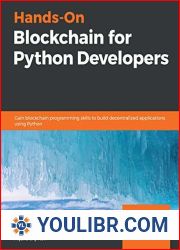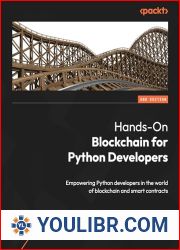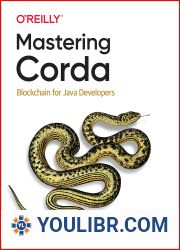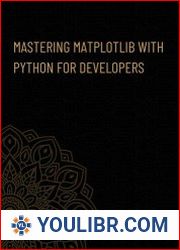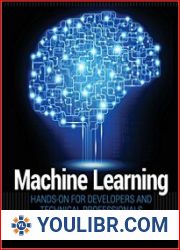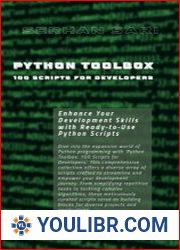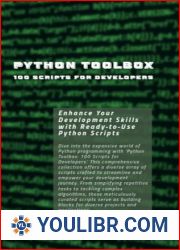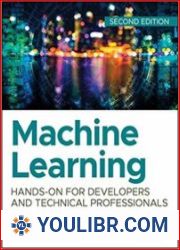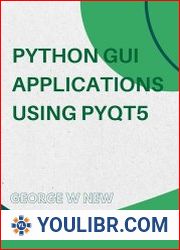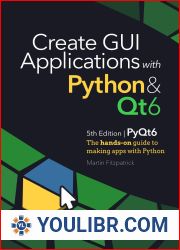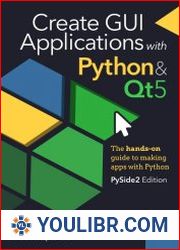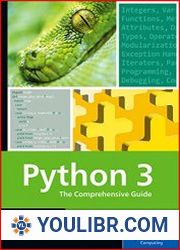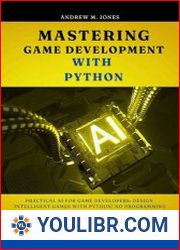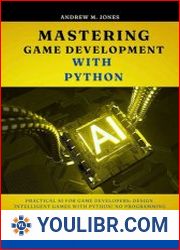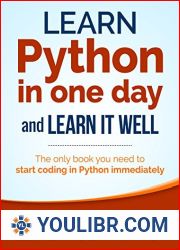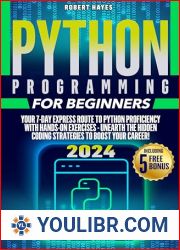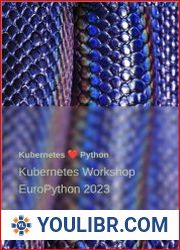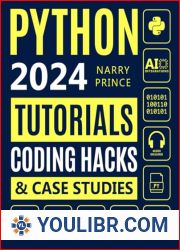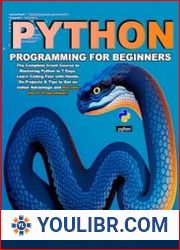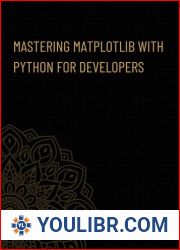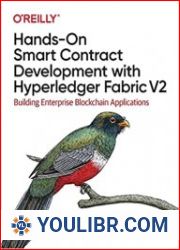
BOOKS - Hands-On Blockchain for Python Developers: Gain blockchain programming skills...

Hands-On Blockchain for Python Developers: Gain blockchain programming skills to build decentralized applications using Python
Author: Arjuna Sky Kok
Year: February 14, 2019
Format: PDF
File size: PDF 13 MB
Language: English
Year: February 14, 2019
Format: PDF
File size: PDF 13 MB
Language: English
Implement real-world decentralized applications using Python, Vyper, Populus, and Ethereum Blockchain is seen as the main technological solution that works as a public ledger for all cryptocurrency transactions. This book serves as a practical guide to developing a full-fledged decentralized application with Python to interact with the various building blocks of blockchain applications. Hands-On Blockchain for Python Developers starts by demonstrating how blockchain technology and cryptocurrency hashing works. You will understand the fundamentals and benefits of smart contracts such as censorship resistance and transaction accuracy. As you steadily progress, you'll go on to build smart contracts using Vyper, which has a similar syntax to Python. This experience will further help you unravel the other benefits of smart contracts, including reliable storage and backup, and efficiency. You'll also use web3.py to interact with smart contracts and leverage the power of both the web3.py and Populus framework to build decentralized applications that offer security and seamless integration with cryptocurrencies. As you explore later chapters, you'll learn how to create your own token on top of Ethereum and build a cryptocurrency wallet graphical user interface (GUI) that can handle Ethereum and Ethereum Request for Comments (ERC-20) tokens using the PySide2 library. This will enable users to seamlessly store, send, and receive digital money. Toward the end, you'll implement InterPlanetary File System (IPFS) technology in your decentralized application to provide a peer-to-peer filesystem that can store and expose media. By the end of this book, you'll be well-versed in blockchain programming and be able to build end-to-end decentralized applications on a range of domains using Python. If you are a Python developer who wants to enter the world of blockchain, Hands-On Blockchain for Python Developers is for you. The book will be your go-to guide to becoming well-versed with the blockchain ecosystem and building your own decentralized applications using Python and library support.
PDFファイルをダウンロード Python開発者のための実用的なブロックチェーンPythonを使用して分散型アプリケーションを構築するためのブロックチェーンプログラミングのスキルを得る download pdf file Hands-On Blockchain for Python Developers: Gain blockchain programming skills to build decentralized applications using Python download pdf file pdf dosyasını indir Python Geliştiricileri için Pratik Blockchain Python kullanarak merkezi olmayan uygulamalar oluşturmak için blockchain programlama becerileri kazanın descargar archivo pdf Blockchain práctico para desarrolladores Python Obtenga habilidades de programación en blockchain para crear aplicaciones descentralizadas utilizando Python تنزيل ملف pdf Blockchain العملية لمطوري Python اكتساب مهارات برمجة blockchain لبناء تطبيقات لامركزية باستخدام Python скачать файл PDF Практический блокчейн для разработчиков Python Получите навыки программирования на блокчейне для создания децентрализованных приложений с использованием Python להוריד קובץ PDF בלוקצ 'יין מעשי למפתחי פייתון להשיג כישורי תכנות בלוקצ'יין לבנות יישומים מבוזרים באמצעות פייתון pdf 파일 다운로드 PDF-Datei herunterladen Praktische Blockchain für Python-Entwickler Erwerben e Blockchain-Programmierkenntnisse, um dezentrale Anwendungen mit Python zu erstellen Scarica il file pdf Blockchain pratica per sviluppatori Python Ottieni competenze di programmazione su blockchain per creare applicazioni decentralizzate con Python 下载 pdf 文件 Python開發人員實用區塊鏈獲取區塊鏈編程技能,以使用Python創建分散式應用程序
pobierz plik pdf Praktyczny Blockchain dla programistów Python Zdobądź umiejętności programowania blockchain, aby budować zdecentralizowane aplikacje za pomocą Pythona descarregar ficheiro pdf Blockchain prático para desenvolvedores Python Obter habilidades de programação em blockchain para criar aplicações descentralizadas usando Python télécharger le fichier pdf Blockchain pratique pour les développeurs Python Obtenez des compétences en programmation sur blockchain pour créer des applications décentralisées en utilisant Python
Реализация реальных децентрализованных приложений с использованием Python, Vyper, Populus и Ethereum Блокчейн рассматривается как основное технологическое решение, которое работает как публичный реестр для всех транзакций криптовалюты. Эта книга служит практическим руководством по разработке полноценного децентрализованного приложения с Python для взаимодействия с различными строительными блоками блокчейн-приложений. Hands-On Blockchain for Python Developers начинает с демонстрации работы технологии блокчейн и хеширования криптовалют. Вы поймете основные принципы и преимущества смарт-контрактов, такие как сопротивление цензуре и точность транзакций. По мере того, как вы неуклонно прогрессируете, вы продолжаете создавать смарт-контракты с помощью Vyper, синтаксис которого похож на Python. Этот опыт еще больше поможет вам раскрыть другие преимущества смарт-контрактов, включая надежное хранение и резервное копирование, а также эффективность. Youll также использует web3.py для взаимодействия со смарт-контрактами и использует возможности фреймворка web3.py и Populus для создания децентрализованных приложений, предлагающих безопасность и бесшовную интеграцию с криптовалютами. Изучая более поздние главы, вы узнаете, как создать свой собственный токен поверх Ethereum и построить графический пользовательский интерфейс (GUI) криптовалютного кошелька, который может обрабатывать токены Ethereum и Ethereum Request for Comments (ERC-20), используя библиотеку Pyde2. Это позволит пользователям беспрепятственно хранить, отправлять и получать цифровые деньги. Ближе к концу вы реализуете технологию InterPlanetary File System (IPFS) в вашем децентрализованном приложении, чтобы обеспечить одноранговую файловую систему, которая может хранить и предоставлять носители. К концу этой книги вы будете хорошо разбираться в блокчейн-программировании и сможете создавать сквозные децентрализованные приложения на ряде доменов, используя Python. Если вы разработчик Python, который хочет войти в мир блокчейна, Hands-On Blockchain for Python Developers для вас. Книга станет вашим путеводителем по знакомству с экосистемой блокчейна и построению собственных децентрализованных приложений с помощью Python и поддержки библиотек.
Implementierung realer dezentraler Anwendungen mit Python, Vyper, Populus und Ethereum Die Blockchain gilt als die wichtigste technologische Lösung, die als öffentliches Register für alle Kryptowährungstransaktionen fungiert. Dieses Buch dient als praktischer Leitfaden für die Entwicklung einer vollständigen dezentralen Anwendung mit Python, um mit den verschiedenen Bausteinen von Blockchain-Anwendungen zu interagieren. Hands-On Blockchain for Python Developers beginnt mit einer Demonstration der Funktionsweise der Blockchain-Technologie und des Hashings von Kryptowährungen. Sie werden die grundlegenden Prinzipien und Vorteile von Smart Contracts wie Zensurresistenz und Transaktionsgenauigkeit verstehen. Wenn Sie stetig Fortschritte machen, werden Sie weiterhin Smart Contracts mit Vyper erstellen, dessen Syntax Python ähnelt. Diese Erfahrung wird Ihnen weiter helfen, andere Vorteile von Smart Contracts zu entdecken, einschließlich zuverlässiger Speicherung und Sicherung sowie Effizienz. Sie werden web3.py auch verwenden, um mit Smart Contracts zu interagieren und die Funktionen des web3.py und Populus Frameworks zu nutzen, um dezentrale Anwendungen zu erstellen, die Sicherheit und nahtlose Integration mit Kryptowährungen bieten. Durch das Studium der folgenden Kapitel erfahren Sie, wie Sie Ihr eigenes Token über Ethereum erstellen und eine grafische Benutzeroberfläche (GUI) einer Kryptowährungs-Wallet erstellen, die Ethereum- und Ethereum Request for Comments-Token (ERC-20) mit der PySide2-Bibliothek verarbeiten kann. Auf diese Weise können Benutzer digitales Geld nahtlos speichern, senden und empfangen. Gegen Ende werden Sie die InterPlanetary File System (IPFS) -Technologie in Ihre dezentrale Anwendung implementieren, um ein Peer-to-Peer-Dateisystem bereitzustellen, das Medien speichern und bereitstellen kann. Am Ende dieses Buches werden Sie ein gutes Verständnis für Blockchain-Programmierung haben und in der Lage sein, End-to-End-dezentrale Anwendungen auf einer Reihe von Domänen mit Python zu erstellen. Wenn Sie ein Python-Entwickler sind, der in die Blockchain-Welt einsteigen möchte, ist die Hands-On-Blockchain für Python-Entwickler genau das Richtige für Sie. Das Buch wird Ihr Leitfaden sein, um das Blockchain-Ökosystem kennenzulernen und Ihre eigenen dezentralen Anwendungen mit Python und Bibliotheksunterstützung aufzubauen.
La implementación de aplicaciones descentralizadas reales utilizando Python, Vyper, Populus y Ethereum Blockchain es considerada como la principal solución tecnológica que funciona como un registro público para todas las transacciones de criptomonedas. Este libro sirve como guía práctica para desarrollar una aplicación totalmente descentralizada con Python para interactuar con los diferentes bloques de construcción de aplicaciones blockchain. Hands-On Blockchain for Python Developers comienza demostrando el funcionamiento de la tecnología blockchain y hash de criptomonedas. Comprenderá los principios básicos y los beneficios de los contratos inteligentes, como la resistencia a la censura y la precisión de las transacciones. A medida que progrese constantemente, seguirá creando contratos inteligentes con Vyper, cuya sintaxis es similar a Python. Esta experiencia le ayudará aún más a revelar otros beneficios de los contratos inteligentes, como el almacenamiento de información confiable y las copias de seguridad, así como la eficiencia. También utilizará web3.py para interactuar con contratos inteligentes y aprovechará las capacidades de framework de web3.py y Populus para crear aplicaciones descentralizadas que ofrezcan seguridad e integración sin problemas con criptomonedas. Al estudiar los capítulos siguientes, aprenderá a crear su propio token en la parte superior de Ethereum y a construir una interfaz gráfica de usuario (GUI) de cartera de criptomonedas que pueda procesar tokens Ethereum y Ethereum Request for Comments (ERC-20) utilizando la biblioteca de PySide2. Esto permitirá a los usuarios almacenar, enviar y recibir dinero digital sin problemas. Hacia el final, introducirá la tecnología InterPlanetary File System (IPFS) en su aplicación descentralizada para proporcionar un sistema de archivos de igual a igual que puede almacenar y proporcionar medios. Al final de este libro, conocerás bien la programación de blockchain y podrás crear aplicaciones descentralizadas de extremo a extremo en varios dominios utilizando Python. Si eres un desarrollador de Python que quiere entrar en el mundo del blockchain, Hands-On Blockchain for Python Developers es para ti. El libro será su guía para familiarizarse con el ecosistema blockchain y construir sus propias aplicaciones descentralizadas con Python y soporte de biblioteca.
Implement real-world decentralized applications using Python, Vyper, Populus, and Ethereum Blockchain is seen as the main technological solution that works as a public ledger for all cryptocurrency transactions. This book serves as a practical guide to developing a full-fledged decentralized application with Python to interact with the various building blocks of blockchain applications. Hands-On Blockchain for Python Developers starts by demonstrating how blockchain technology and cryptocurrency hashing works. You will understand the fundamentals and benefits of smart contracts such as censorship resistance and transaction accuracy. As you steadily progress, you'll go on to build smart contracts using Vyper, which has a similar syntax to Python. This experience will further help you unravel the other benefits of smart contracts, including reliable storage and backup, and efficiency. You'll also use web3.py to interact with smart contracts and leverage the power of both the web3.py and Populus framework to build decentralized applications that offer security and seamless integration with cryptocurrencies. As you explore later chapters, you'll learn how to create your own token on top of Ethereum and build a cryptocurrency wallet graphical user interface (GUI) that can handle Ethereum and Ethereum Request for Comments (ERC-20) tokens using the PySide2 library. This will enable users to seamlessly store, send, and receive digital money. Toward the end, you'll implement InterPlanetary File System (IPFS) technology in your decentralized application to provide a peer-to-peer filesystem that can store and expose media. By the end of this book, you'll be well-versed in blockchain programming and be able to build end-to-end decentralized applications on a range of domains using Python. If you are a Python developer who wants to enter the world of blockchain, Hands-On Blockchain for Python Developers is for you. The book will be your go-to guide to becoming well-versed with the blockchain ecosystem and building your own decentralized applications using Python and library support.
Implémentation d'applications décentralisées réelles utilisant Python, Vyper, Populus et Ethereum Blockchain est considéré comme la principale solution technologique qui fonctionne comme un registre public pour toutes les transactions de crypto-monnaies. Ce livre sert de guide pratique pour le développement d'une application décentralisée complète avec Python pour interagir avec les différents blocs de construction des applications blockchain. Hands-On Blockchain for Python Developers commence par démontrer le fonctionnement de la technologie blockchain et le hachage des crypto-monnaies. Vous comprendrez les principes de base et les avantages des contrats intelligents, tels que la résistance à la censure et la précision des transactions. Au fur et à mesure que vous progresserez régulièrement, vous continuerez à créer des contrats intelligents avec Vyper, dont la syntaxe est similaire à celle de Python. Cette expérience vous aidera encore plus à découvrir d'autres avantages des contrats intelligents, y compris le stockage et la sauvegarde fiables, ainsi que l'efficacité. Vous utiliserez également les web3.py pour interagir avec les contrats intelligents et utiliser les fonctionnalités du cadre web3.py et Populus pour créer des applications décentralisées offrant une sécurité et une intégration transparente avec les crypto-monnaies. En étudiant les chapitres suivants, vous apprendrez comment créer votre propre token sur Ethereum et construire une interface utilisateur graphique (GUI) d'un portefeuille de crypto-monnaie qui peut gérer les tokens Ethereum et Ethereum Request for Comments (ERC-20) en utilisant la bibliothèque de PySide2. Cela permettra aux utilisateurs de stocker, d'envoyer et de recevoir de l'argent numérique en toute transparence. Vers la fin, vous introduirez la technologie IPFS (InterPlanetary File System) dans votre application décentralisée pour fournir un système de fichiers pair à pair qui peut stocker et fournir des médias. À la fin de ce livre, vous comprendrez bien la programmation blockchain et serez en mesure de créer des applications décentralisées de bout en bout sur un certain nombre de domaines en utilisant Python. Si vous êtes un développeur Python qui veut entrer dans le monde du blockchain, Hands-On Blockchain for Python Developers est fait pour vous. Le livre sera votre guide pour découvrir l'écosystème de la blockchain et construire vos propres applications décentralisées avec Python et le support des bibliothèques.
A implementação de aplicações descentralizadas reais usando Python, Vyper, Populus e Ethereum Blockchain é considerada a principal solução tecnológica que funciona como um registro público para todas as transações de criptomonedas. Este livro serve de guia prático para desenvolver uma aplicação descentralizada completa com Python para interagir com diversos blocos de construção de aplicativos de blockchain. Hands-On Blockchain for Python Developers começa com uma demonstração do funcionamento da tecnologia blockchain e da hasteação de criptomonedas. Você compreenderá os princípios e benefícios básicos dos contratos inteligentes, como a resistência à censura e a precisão das transações. À medida que você progride de forma constante, você continuará criando contratos inteligentes usando o Vyper, cuja sintaxe é semelhante ao Python. Esta experiência irá ajudá-lo ainda mais a revelar outras vantagens dos contratos inteligentes, incluindo o armazenamento e o backups confiáveis e a eficiência. Você também usará o web3.py para interagir com contratos inteligentes e usará as funcionalidades do quadro web3.py e Populus para criar aplicações descentralizadas que ofereçam segurança e integração indefensável com criptomonedas. Ao pesquisar os capítulos seguintes, você vai aprender como criar seu próprio token acima do Ethereum e construir uma interface gráfica de usuário (GUI) da carteira de criptomonedas que pode processar os tocens Ethereum e Ethereum Request for Comments (ERC-20) usando a biblioteca PySide2. Isso permite que os usuários armazenem, enviem e recebam dinheiro digital sem problemas. Perto do fim, você vai introduzir a tecnologia «InterPlanetary System» (IPFS) em seu aplicativo descentralizado para fornecer um sistema de arquivos de um nível único que pode armazenar e fornecer mídia. Ao final deste livro, você terá uma boa experiência na programação de blockchain e poderá criar aplicações descentralizadas em vários domínios usando Python. Se você é um desenvolvedor Python que quer entrar no mundo do blockchain, Hands-On Blockchain for Python Developers para você. O livro será seu guia para conhecer o ecossistema blockchain e construir suas próprias aplicações descentralizadas com Python e suporte às bibliotecas.
L'implementazione di reali applicazioni decentralizzate con Python, Vyper, Populus ed Ethereum Blockchain è considerata una soluzione tecnologica di base che funziona come un registro pubblico per tutte le transazioni di criptovaluta. Questo libro fornisce una guida pratica allo sviluppo di un'applicazione decentralizzata completa con Python per interagire con diversi blockchain. Hands-On Blockchain for Python Developers inizia con la dimostrazione del funzionamento della tecnologia blockchain e l'hashtag delle criptovalute. Si comprenderanno i principi e i vantaggi fondamentali dei contratti smart, come la resistenza alla censura e l'accuratezza delle transazioni. Mentre si progredisce costantemente, si continuerà a creare contratti smart con Vyper, la cui sintassi è simile a Python. Questa esperienza consente di sfruttare ulteriormente gli altri vantaggi dei contratti smart, tra cui lo storage affidabile, il backup e l'efficienza. Si utilizzerà anche il web3.py per interagire con i contratti smart e utilizzare le funzionalità del framework web3.py e Populus per creare applicazioni decentralizzate che offrono sicurezza e integrazione senza problemi con le criptovalute. Studiando i capitoli successivi, scoprirete come creare il proprio token sopra Ethereum e costruire un'interfaccia utente grafica (GUI) portafoglio criptovaluta in grado di elaborare i token Ethereum ed Ethereum Sollest for Comments (ERC-20) utilizzando la libreria di PySide2. Questo consente agli utenti di memorizzare, inviare e ricevere denaro digitale senza problemi. Verso la fine, implementare la tecnologia IPFS (File System) nella vostra applicazione decentralizzata per fornire un file system a periferica in grado di memorizzare e fornire i supporti. Alla fine di questo libro, potrai conoscere bene la programmazione blockchain e creare applicazioni decentralizzate complete su diversi domini utilizzando Python. Se sei uno sviluppatore Python che vuole entrare nel mondo della blockchain, Hands-On Blockchain for Python Developers per voi. Il libro sarà la guida per conoscere l'ecosistema della blockchain e creare le proprie applicazioni decentralizzate con Python e il supporto alle librerie.
Реализация реальных децентрализованных приложений с использованием Python, Vyper, Populus и Ethereum Блокчейн рассматривается как основное технологическое решение, которое работает как публичный реестр для всех транзакций криптовалюты. Эта книга служит практическим руководством по разработке полноценного децентрализованного приложения с Python для взаимодействия с различными строительными блоками блокчейн-приложений. Hands-On Blockchain for Python Developers начинает с демонстрации работы технологии блокчейн и хеширования криптовалют. Вы поймете основные принципы и преимущества смарт-контрактов, такие как сопротивление цензуре и точность транзакций. По мере того, как вы неуклонно прогрессируете, вы продолжаете создавать смарт-контракты с помощью Vyper, синтаксис которого похож на Python. Этот опыт еще больше поможет вам раскрыть другие преимущества смарт-контрактов, включая надежное хранение и резервное копирование, а также эффективность. Youll также использует web3.py для взаимодействия со смарт-контрактами и использует возможности фреймворка web3.py и Populus для создания децентрализованных приложений, предлагающих безопасность и бесшовную интеграцию с криптовалютами. Изучая более поздние главы, вы узнаете, как создать свой собственный токен поверх Ethereum и построить графический пользовательский интерфейс (GUI) криптовалютного кошелька, который может обрабатывать токены Ethereum и Ethereum Request for Comments (ERC-20), используя библиотеку Pyde2. Это позволит пользователям беспрепятственно хранить, отправлять и получать цифровые деньги. Ближе к концу вы реализуете технологию InterPlanetary File System (IPFS) в вашем децентрализованном приложении, чтобы обеспечить одноранговую файловую систему, которая может хранить и предоставлять носители. К концу этой книги вы будете хорошо разбираться в блокчейн-программировании и сможете создавать сквозные децентрализованные приложения на ряде доменов, используя Python. Если вы разработчик Python, который хочет войти в мир блокчейна, Hands-On Blockchain for Python Developers для вас. Книга станет вашим путеводителем по знакомству с экосистемой блокчейна и построению собственных децентрализованных приложений с помощью Python и поддержки библиотек.
Implementierung realer dezentraler Anwendungen mit Python, Vyper, Populus und Ethereum Die Blockchain gilt als die wichtigste technologische Lösung, die als öffentliches Register für alle Kryptowährungstransaktionen fungiert. Dieses Buch dient als praktischer Leitfaden für die Entwicklung einer vollständigen dezentralen Anwendung mit Python, um mit den verschiedenen Bausteinen von Blockchain-Anwendungen zu interagieren. Hands-On Blockchain for Python Developers beginnt mit einer Demonstration der Funktionsweise der Blockchain-Technologie und des Hashings von Kryptowährungen. Sie werden die grundlegenden Prinzipien und Vorteile von Smart Contracts wie Zensurresistenz und Transaktionsgenauigkeit verstehen. Wenn Sie stetig Fortschritte machen, werden Sie weiterhin Smart Contracts mit Vyper erstellen, dessen Syntax Python ähnelt. Diese Erfahrung wird Ihnen weiter helfen, andere Vorteile von Smart Contracts zu entdecken, einschließlich zuverlässiger Speicherung und Sicherung sowie Effizienz. Sie werden web3.py auch verwenden, um mit Smart Contracts zu interagieren und die Funktionen des web3.py und Populus Frameworks zu nutzen, um dezentrale Anwendungen zu erstellen, die Sicherheit und nahtlose Integration mit Kryptowährungen bieten. Durch das Studium der folgenden Kapitel erfahren Sie, wie Sie Ihr eigenes Token über Ethereum erstellen und eine grafische Benutzeroberfläche (GUI) einer Kryptowährungs-Wallet erstellen, die Ethereum- und Ethereum Request for Comments-Token (ERC-20) mit der PySide2-Bibliothek verarbeiten kann. Auf diese Weise können Benutzer digitales Geld nahtlos speichern, senden und empfangen. Gegen Ende werden Sie die InterPlanetary File System (IPFS) -Technologie in Ihre dezentrale Anwendung implementieren, um ein Peer-to-Peer-Dateisystem bereitzustellen, das Medien speichern und bereitstellen kann. Am Ende dieses Buches werden Sie ein gutes Verständnis für Blockchain-Programmierung haben und in der Lage sein, End-to-End-dezentrale Anwendungen auf einer Reihe von Domänen mit Python zu erstellen. Wenn Sie ein Python-Entwickler sind, der in die Blockchain-Welt einsteigen möchte, ist die Hands-On-Blockchain für Python-Entwickler genau das Richtige für Sie. Das Buch wird Ihr Leitfaden sein, um das Blockchain-Ökosystem kennenzulernen und Ihre eigenen dezentralen Anwendungen mit Python und Bibliotheksunterstützung aufzubauen.
La implementación de aplicaciones descentralizadas reales utilizando Python, Vyper, Populus y Ethereum Blockchain es considerada como la principal solución tecnológica que funciona como un registro público para todas las transacciones de criptomonedas. Este libro sirve como guía práctica para desarrollar una aplicación totalmente descentralizada con Python para interactuar con los diferentes bloques de construcción de aplicaciones blockchain. Hands-On Blockchain for Python Developers comienza demostrando el funcionamiento de la tecnología blockchain y hash de criptomonedas. Comprenderá los principios básicos y los beneficios de los contratos inteligentes, como la resistencia a la censura y la precisión de las transacciones. A medida que progrese constantemente, seguirá creando contratos inteligentes con Vyper, cuya sintaxis es similar a Python. Esta experiencia le ayudará aún más a revelar otros beneficios de los contratos inteligentes, como el almacenamiento de información confiable y las copias de seguridad, así como la eficiencia. También utilizará web3.py para interactuar con contratos inteligentes y aprovechará las capacidades de framework de web3.py y Populus para crear aplicaciones descentralizadas que ofrezcan seguridad e integración sin problemas con criptomonedas. Al estudiar los capítulos siguientes, aprenderá a crear su propio token en la parte superior de Ethereum y a construir una interfaz gráfica de usuario (GUI) de cartera de criptomonedas que pueda procesar tokens Ethereum y Ethereum Request for Comments (ERC-20) utilizando la biblioteca de PySide2. Esto permitirá a los usuarios almacenar, enviar y recibir dinero digital sin problemas. Hacia el final, introducirá la tecnología InterPlanetary File System (IPFS) en su aplicación descentralizada para proporcionar un sistema de archivos de igual a igual que puede almacenar y proporcionar medios. Al final de este libro, conocerás bien la programación de blockchain y podrás crear aplicaciones descentralizadas de extremo a extremo en varios dominios utilizando Python. Si eres un desarrollador de Python que quiere entrar en el mundo del blockchain, Hands-On Blockchain for Python Developers es para ti. El libro será su guía para familiarizarse con el ecosistema blockchain y construir sus propias aplicaciones descentralizadas con Python y soporte de biblioteca.
Implement real-world decentralized applications using Python, Vyper, Populus, and Ethereum Blockchain is seen as the main technological solution that works as a public ledger for all cryptocurrency transactions. This book serves as a practical guide to developing a full-fledged decentralized application with Python to interact with the various building blocks of blockchain applications. Hands-On Blockchain for Python Developers starts by demonstrating how blockchain technology and cryptocurrency hashing works. You will understand the fundamentals and benefits of smart contracts such as censorship resistance and transaction accuracy. As you steadily progress, you'll go on to build smart contracts using Vyper, which has a similar syntax to Python. This experience will further help you unravel the other benefits of smart contracts, including reliable storage and backup, and efficiency. You'll also use web3.py to interact with smart contracts and leverage the power of both the web3.py and Populus framework to build decentralized applications that offer security and seamless integration with cryptocurrencies. As you explore later chapters, you'll learn how to create your own token on top of Ethereum and build a cryptocurrency wallet graphical user interface (GUI) that can handle Ethereum and Ethereum Request for Comments (ERC-20) tokens using the PySide2 library. This will enable users to seamlessly store, send, and receive digital money. Toward the end, you'll implement InterPlanetary File System (IPFS) technology in your decentralized application to provide a peer-to-peer filesystem that can store and expose media. By the end of this book, you'll be well-versed in blockchain programming and be able to build end-to-end decentralized applications on a range of domains using Python. If you are a Python developer who wants to enter the world of blockchain, Hands-On Blockchain for Python Developers is for you. The book will be your go-to guide to becoming well-versed with the blockchain ecosystem and building your own decentralized applications using Python and library support.
Implémentation d'applications décentralisées réelles utilisant Python, Vyper, Populus et Ethereum Blockchain est considéré comme la principale solution technologique qui fonctionne comme un registre public pour toutes les transactions de crypto-monnaies. Ce livre sert de guide pratique pour le développement d'une application décentralisée complète avec Python pour interagir avec les différents blocs de construction des applications blockchain. Hands-On Blockchain for Python Developers commence par démontrer le fonctionnement de la technologie blockchain et le hachage des crypto-monnaies. Vous comprendrez les principes de base et les avantages des contrats intelligents, tels que la résistance à la censure et la précision des transactions. Au fur et à mesure que vous progresserez régulièrement, vous continuerez à créer des contrats intelligents avec Vyper, dont la syntaxe est similaire à celle de Python. Cette expérience vous aidera encore plus à découvrir d'autres avantages des contrats intelligents, y compris le stockage et la sauvegarde fiables, ainsi que l'efficacité. Vous utiliserez également les web3.py pour interagir avec les contrats intelligents et utiliser les fonctionnalités du cadre web3.py et Populus pour créer des applications décentralisées offrant une sécurité et une intégration transparente avec les crypto-monnaies. En étudiant les chapitres suivants, vous apprendrez comment créer votre propre token sur Ethereum et construire une interface utilisateur graphique (GUI) d'un portefeuille de crypto-monnaie qui peut gérer les tokens Ethereum et Ethereum Request for Comments (ERC-20) en utilisant la bibliothèque de PySide2. Cela permettra aux utilisateurs de stocker, d'envoyer et de recevoir de l'argent numérique en toute transparence. Vers la fin, vous introduirez la technologie IPFS (InterPlanetary File System) dans votre application décentralisée pour fournir un système de fichiers pair à pair qui peut stocker et fournir des médias. À la fin de ce livre, vous comprendrez bien la programmation blockchain et serez en mesure de créer des applications décentralisées de bout en bout sur un certain nombre de domaines en utilisant Python. Si vous êtes un développeur Python qui veut entrer dans le monde du blockchain, Hands-On Blockchain for Python Developers est fait pour vous. Le livre sera votre guide pour découvrir l'écosystème de la blockchain et construire vos propres applications décentralisées avec Python et le support des bibliothèques.
A implementação de aplicações descentralizadas reais usando Python, Vyper, Populus e Ethereum Blockchain é considerada a principal solução tecnológica que funciona como um registro público para todas as transações de criptomonedas. Este livro serve de guia prático para desenvolver uma aplicação descentralizada completa com Python para interagir com diversos blocos de construção de aplicativos de blockchain. Hands-On Blockchain for Python Developers começa com uma demonstração do funcionamento da tecnologia blockchain e da hasteação de criptomonedas. Você compreenderá os princípios e benefícios básicos dos contratos inteligentes, como a resistência à censura e a precisão das transações. À medida que você progride de forma constante, você continuará criando contratos inteligentes usando o Vyper, cuja sintaxe é semelhante ao Python. Esta experiência irá ajudá-lo ainda mais a revelar outras vantagens dos contratos inteligentes, incluindo o armazenamento e o backups confiáveis e a eficiência. Você também usará o web3.py para interagir com contratos inteligentes e usará as funcionalidades do quadro web3.py e Populus para criar aplicações descentralizadas que ofereçam segurança e integração indefensável com criptomonedas. Ao pesquisar os capítulos seguintes, você vai aprender como criar seu próprio token acima do Ethereum e construir uma interface gráfica de usuário (GUI) da carteira de criptomonedas que pode processar os tocens Ethereum e Ethereum Request for Comments (ERC-20) usando a biblioteca PySide2. Isso permite que os usuários armazenem, enviem e recebam dinheiro digital sem problemas. Perto do fim, você vai introduzir a tecnologia «InterPlanetary System» (IPFS) em seu aplicativo descentralizado para fornecer um sistema de arquivos de um nível único que pode armazenar e fornecer mídia. Ao final deste livro, você terá uma boa experiência na programação de blockchain e poderá criar aplicações descentralizadas em vários domínios usando Python. Se você é um desenvolvedor Python que quer entrar no mundo do blockchain, Hands-On Blockchain for Python Developers para você. O livro será seu guia para conhecer o ecossistema blockchain e construir suas próprias aplicações descentralizadas com Python e suporte às bibliotecas.
L'implementazione di reali applicazioni decentralizzate con Python, Vyper, Populus ed Ethereum Blockchain è considerata una soluzione tecnologica di base che funziona come un registro pubblico per tutte le transazioni di criptovaluta. Questo libro fornisce una guida pratica allo sviluppo di un'applicazione decentralizzata completa con Python per interagire con diversi blockchain. Hands-On Blockchain for Python Developers inizia con la dimostrazione del funzionamento della tecnologia blockchain e l'hashtag delle criptovalute. Si comprenderanno i principi e i vantaggi fondamentali dei contratti smart, come la resistenza alla censura e l'accuratezza delle transazioni. Mentre si progredisce costantemente, si continuerà a creare contratti smart con Vyper, la cui sintassi è simile a Python. Questa esperienza consente di sfruttare ulteriormente gli altri vantaggi dei contratti smart, tra cui lo storage affidabile, il backup e l'efficienza. Si utilizzerà anche il web3.py per interagire con i contratti smart e utilizzare le funzionalità del framework web3.py e Populus per creare applicazioni decentralizzate che offrono sicurezza e integrazione senza problemi con le criptovalute. Studiando i capitoli successivi, scoprirete come creare il proprio token sopra Ethereum e costruire un'interfaccia utente grafica (GUI) portafoglio criptovaluta in grado di elaborare i token Ethereum ed Ethereum Sollest for Comments (ERC-20) utilizzando la libreria di PySide2. Questo consente agli utenti di memorizzare, inviare e ricevere denaro digitale senza problemi. Verso la fine, implementare la tecnologia IPFS (File System) nella vostra applicazione decentralizzata per fornire un file system a periferica in grado di memorizzare e fornire i supporti. Alla fine di questo libro, potrai conoscere bene la programmazione blockchain e creare applicazioni decentralizzate complete su diversi domini utilizzando Python. Se sei uno sviluppatore Python che vuole entrare nel mondo della blockchain, Hands-On Blockchain for Python Developers per voi. Il libro sarà la guida per conoscere l'ecosistema della blockchain e creare le proprie applicazioni decentralizzate con Python e il supporto alle librerie.







